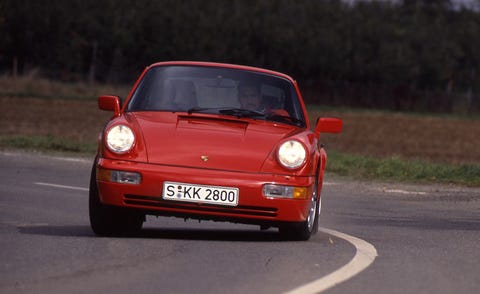View Photos

WOLFGANG FALKCar and Driver
From the January 1990 issue of Car and Driver.
It’s a scene right out of a movie, a fantasy that only the Germans and a few lucky visitors will ever live. The headlights of a bright-red Porsche 911 Carrera 2 drill twin cones through the lifting morning mist. The straight, flat ribbon of deserted autobahn scrolls madly into the horizon as the kilometer markers flash past. The speedometer registers a steady 282kph. The tachometer needle flirts with the redline. And the accelerator pedal stays flat to the floor—where it has been for the past five minutes.
The Porsche continues to hurtle down the A6 autobahn for another four and a half minutes before traffic conspires to slow our progress. Then we turn around and repeat the sprint in the other direction. Later, the two timed runs complete and the Porsche idling at a rest stop, the calculator reveals all. Top speed of the new Porsche 911 Carrera 2: 161 mph.
If you’ve ever looked longingly at a 911, you now have even more fire for your lust. The Carrera 2 is the newest generation of the age-old 911 concept, and it may just be the most exciting yet. Not only does it build on the traditional appeal of the 911, but it is faster, gutsier, more stable, and more satisfying. The Carrera 2 has all the unmistakable 911 flair and style—without all of the old car’s vices.
The Carrera 2 is the rear-wheel-drive version of the much lauded four-wheel-drive Carrera 4. It uses the same body, the same chassis, the same engine, and the same five-speed gearbox. Indeed, from the outside the two cars are visually identical, save for the badges on their tails. And the only difference in the cockpit is the number of switches that sit ahead of the gear lever on the center console. The Carrera 2 has only one, an override for manually raising or lowering the automatic rear wing, while the Carrera 4 also has another for altering the four-wheel-drive program.
The Carrera 2 is equipped with standard dual air bags—as is the 1990 Carrera 4. (In fact, dual air bags—and anti-lock brakes—are now standard on all Porsches.) This means that both cars use the same air-bag-equipped steering wheel found in the 944S2. Each car’s passenger-side air bag is located in the space once occupied by the glove box, which now sits under the dash. Aside from these changes, however, the layout looks familiar enough that traditionalists will feel quite at home.
Because the Carrera 2 so closely resembles its four-wheel-drive sibling, it’s no surprise that it bears all the basic goodness of the Carrera 4. Open the door and slide into the cockpit and the same supportive and comfortable bucket seat envelopes you. The driving position is every bit as comfortable as in the Carrera 4. The pedals remain perfect for heel-and-toe waltzes. And when you turn the key—still on the traditional left-hand side of the steering wheel—the engine fires with a familiar gruff bark that thrills you with anticipation. It takes only a few moments of working the fine controls to satisfy that anticipation.
The gear lever slides into position firmly and deliberately. The clutch take-up is smooth and progressive. The standard power steering filters out any harsh messages from the front suspension and yet faithfully reports the activities of the tires’ contact patches to your hands. And the brakes bite with power and unfailing resolve—using them hard is like firing a pack of retro-rockets. These businesslike controls fortify the Carrera 2’s driver’s car demeanor and make this an exceptionally agreeable car to use.
This content is created and maintained by a third party, and imported onto this page to help users provide their email addresses. You may be able to find more information about this and similar content at piano.io





